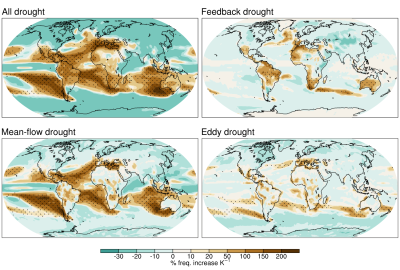Mechanisms of Global Drought Intensification in the 21st Century
Future changes to drought around the globe remain highly uncertain. Here, we analyze the atmosphere's moisture budget to understand agreements and disagreements between global climate models regarding where drought will increase and by how much.
By analyzing the mechanisms by which drought is delivered, we can understand the strengths and limitations of global climate models in projecting future drought. This allows us a superior understanding of the reliability of future drought projections across models.
Future projections of global meteorological drought are evaluated in the Multi-Model Large Ensemble Archive, including an evaluation of the atmospheric moisture budget, conditioned on drought years. The moisture-budget decomposition allows drought to be defined as mean-flow, eddy, or feedback droughts, depending on which term in the equation contributes the largest negative interannual anomaly. In the historical climate, mean-flow droughts constitute most droughts at low latitudes; eddy droughts are equally common at higher latitudes; feedback droughts (i.e., droughts exacerbated by land–atmosphere feedbacks) constitute almost all droughts in water-limited subtropical/Mediterranean regions. Drought increases in frequency over the subtropics, in addition to certain tropical regions, consistent with previous studies. These increases are predominantly due to increases in feedback droughts in regions where these droughts are common historically but also over the Amazon. Model uncertainty is particularly large over the Amazon and Australia, a reflection of model diversity in processes associated with land-atmosphere interaction. Based on these results, the availability of 3-D atmospheric data from a wider swath of global climate model large ensembles could help constrain global drought projections based on the representation of drought mechanisms in the historical climate.

